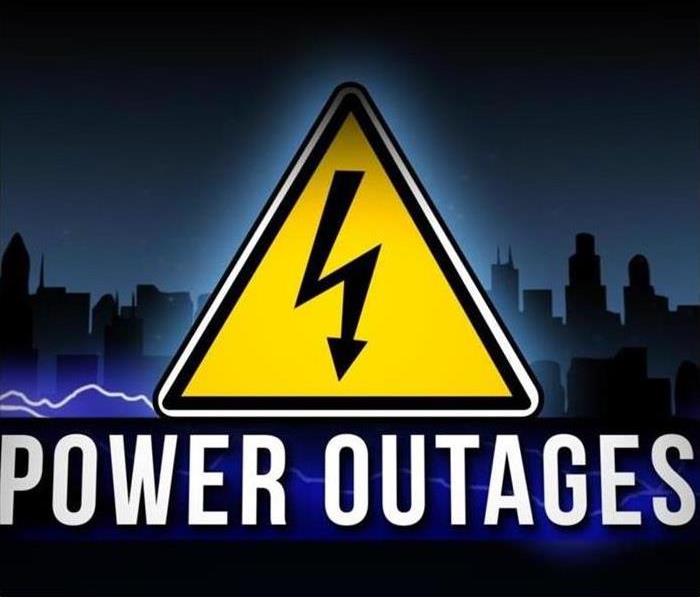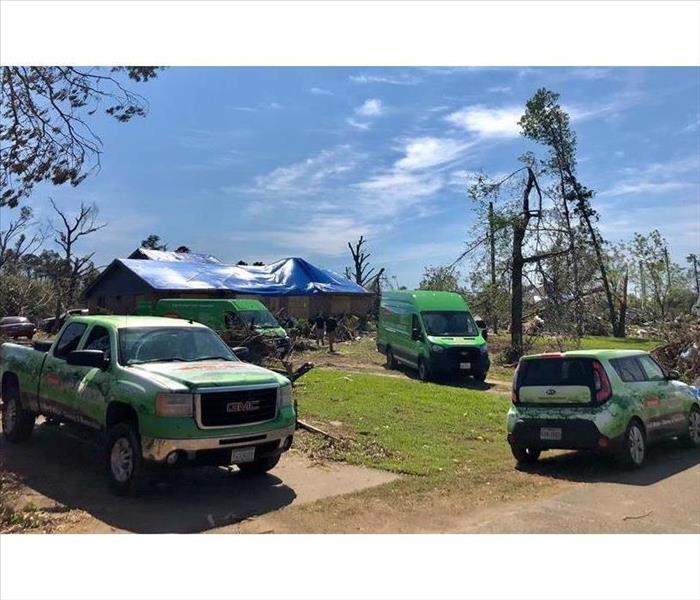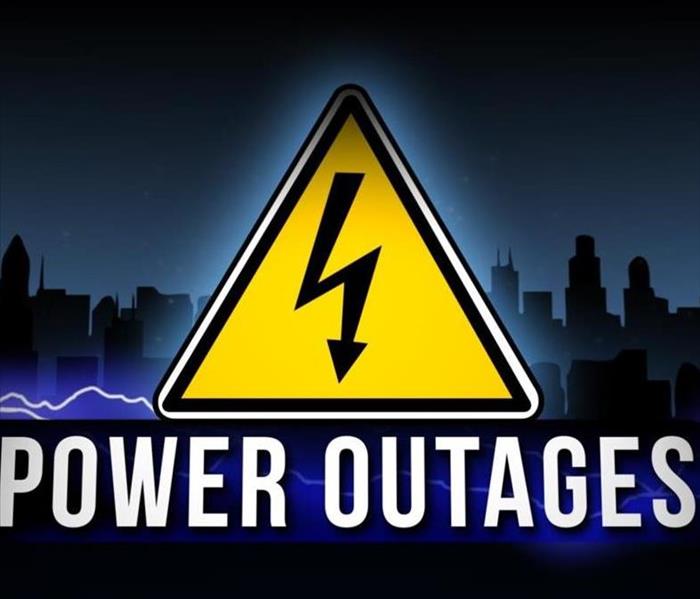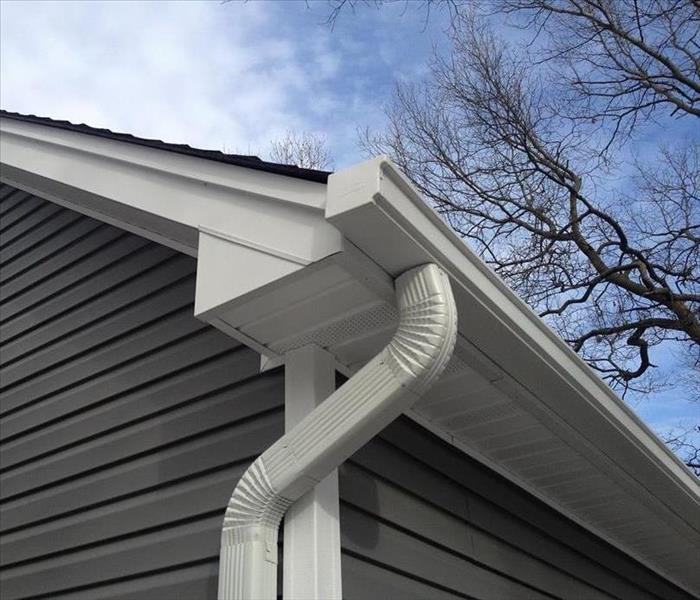Archived Storm Damage Blog Posts
SERVPRO of Longview Roof-Tarp and Board-Up Services: Protecting Your Property After a Storm
2/25/2025 (Permalink)
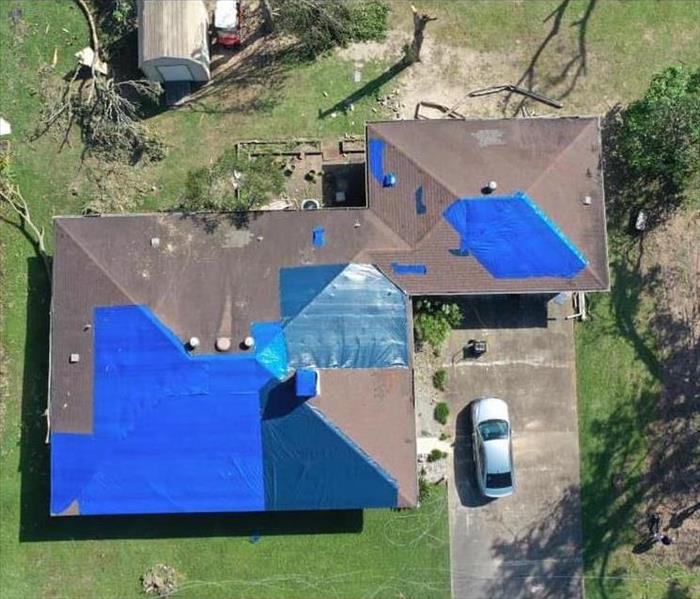 SERVPRO of Longview Roof-Tarp and Board-Up Services: Protecting Your Property After a Storm.
SERVPRO of Longview Roof-Tarp and Board-Up Services: Protecting Your Property After a Storm.
SERVPRO of Longview Roof-Tarp and Board-Up Services: Protecting Your Property After a Storm
When an east Texas storm strikes, the damage to your home or business can be overwhelming. Protecting your property quickly is crucial to prevent further harm, whether it's a compromised roof, broken windows, or damaged walls.
Why Roof-Tarp and Board-Up Services Matter
Storm damage in Longview doesn't stop once the clouds clear. Rain, wind, and even unwanted guests — both animals and people — can take advantage of any openings left behind. That's where our roof tarp and board-up services come in:
- Roof Tarp Service: We provide high-quality roof tarps to cover exposed areas, preventing water damage and protecting your property until SERVPRO of Longview can make permanent repairs.
- Board-Up Service: Our board-up solutions secure broken windows, doors, and walls, keeping your property safe from weather elements, pests, and illegal entry.
Residential Storm Damage Restoration
We know that storms don't wait for business hours, so we don't either. Our service professionals are on call 24/7/365, including weekends and holidays, to help you recover from residential and commercial storm damage.
Our local storm damage services include:
- Residential Flooding and Storm Cleanup
- Severe Weather Damage Restoration
- Wind Damage and Wildfire Cleanup
- Flood Water Removal and Cleanup
When the unexpected happens, you can count on us to respond quickly and work efficiently to restore your property. Don't let storm damage linger — protect your home or business today.
Contact SERVPRO of Longview anytime for fast and reliable storm damage restoration (903) 238-8100.
Using a FLIR Meter to Detect Moisture After Water Damage
9/30/2024 (Permalink)
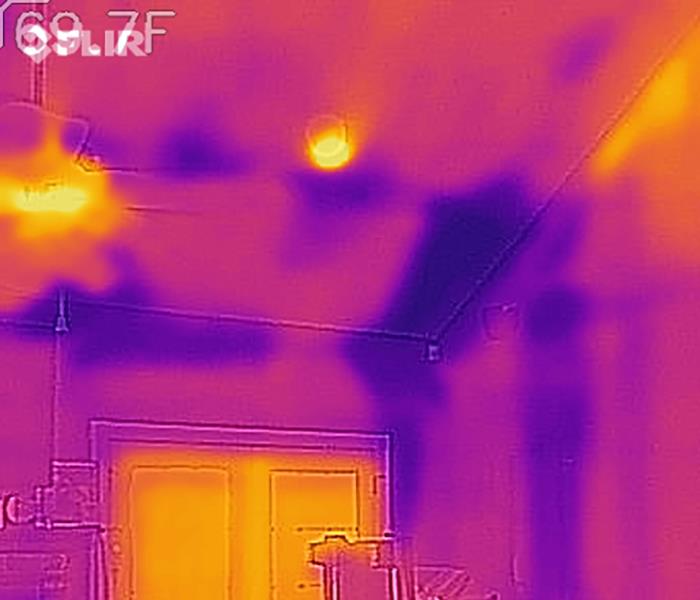 By using a FLIR meter, professionals can pinpoint areas that need drying, helping prevent long-term issues.
By using a FLIR meter, professionals can pinpoint areas that need drying, helping prevent long-term issues.
After water damage in your home, you need to worry about more than visible water. Hidden moisture can seep into walls, floors, and ceilings, creating the perfect environment for mold growth and long-term structural damage. That’s why at SERVPRO®, we use advanced technology like FLIR meters to detect moisture that can’t be seen by the naked eye.
A FLIR meter is a thermal imaging tool that identifies temperature differences in your home’s structure. When water is trapped behind walls or under flooring, it often creates cooler spots, which the FLIR meter highlights with precision. This allows our SERVPRO technicians to accurately identify problem areas and take immediate action, ensuring that every inch of your home is properly dried.
By using FLIR meters, we don’t just restore your home’s surface—we target hidden moisture to prevent further damage and health risks. With this technology, SERVPRO ensures that your home is completely restored, giving you peace of mind and protecting your property for the long term. When you choose SERVPRO, you're not just getting quick service; you're getting thorough, professional care with the best tools available!
The Hidden Dangers of Falling Trees Near Your Home
6/20/2024 (Permalink)
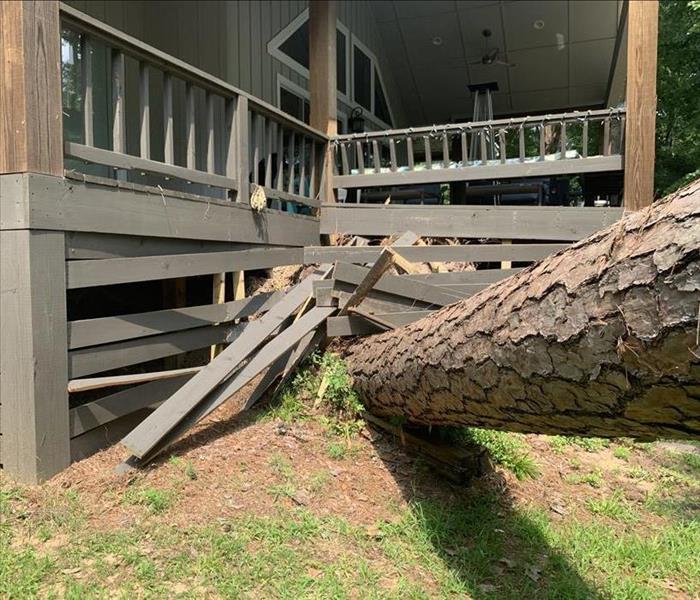 The Hidden Dangers of Falling Trees Near Your Longview Texas Home!
The Hidden Dangers of Falling Trees Near Your Longview Texas Home!
As serene and picturesque as a home surrounded by trees can be, it's essential to recognize the potential risks that come with it, especially the threat of falling trees. While trees offer shade, beauty, and environmental benefits, they can also pose significant hazards if not properly maintained.
The Risks of Falling Trees
1. Property Damage: Falling trees or branches can cause severe damage to your home, vehicles, and other structures. The impact can lead to costly repairs, not to mention the potential for temporary displacement if your home becomes uninhabitable.
2. Personal Injury: The danger extends beyond property damage. Falling trees can cause serious injuries or even fatalities. It's crucial to consider the safety of your family, guests, and pets.
3. Utility Disruptions: Trees falling on power lines can lead to electrical outages, posing a risk of fire and hindering emergency response efforts. Downed power lines can also be extremely dangerous to approach.
Prevention and Safety Tips
1. Regular Inspections: Conduct regular inspections of the trees around your property. Look for signs of disease, decay, or structural weaknesses. Professional arborists can provide thorough assessments and recommend necessary actions.
2. Prune and Maintain: Routine pruning helps maintain tree health and reduces the risk of falling branches. Remove dead or overhanging branches, and consider trimming back trees that are too close to your home.
3. Remove Hazardous Trees: If a tree is identified as hazardous, removal might be necessary. Although this can be a tough decision, the safety benefits often outweigh the sentimental value of the tree.
4. Monitor Weather Conditions: Extreme weather conditions, such as heavy winds, storms, and ice, increase the likelihood of trees falling. Stay informed about weather forecasts and take precautionary measures during adverse conditions.
5. Create a Safety Plan: Have an emergency plan in place for your family. Know where to seek shelter within your home and have an emergency kit ready in case of power outages or structural damage.
Conclusion
While trees add significant value and beauty to your property, it's crucial to stay vigilant about the risks they can pose. Regular maintenance, professional assessments, and a proactive approach to tree care can help ensure that your home remains a safe and beautiful haven.
By taking these steps, you can enjoy the benefits of having trees around your home while minimizing the risks associated with falling trees. Stay safe and proactive, and your leafy neighbors will continue to be a source of joy rather than worry.
You can always contact SERVPRO of Longview for emergency mitigation services at 903-238-8100 24/7/365.
Navigating April Weather
4/3/2024 (Permalink)
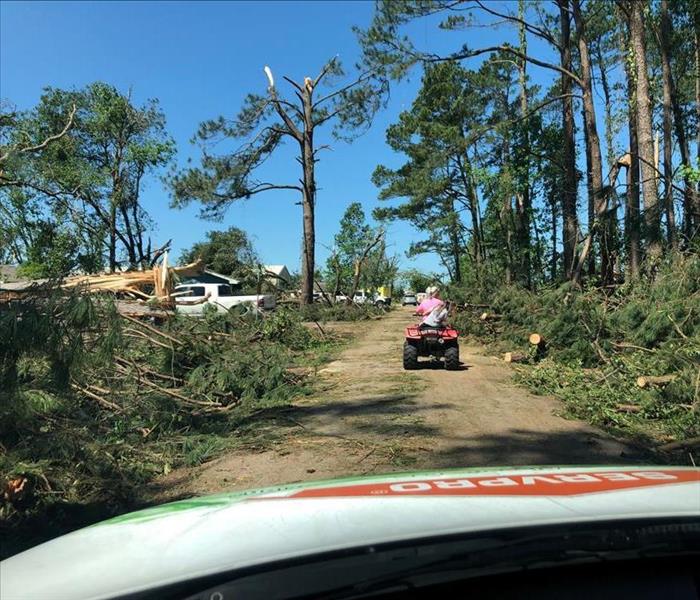 Navigating this storm-damaged community was difficult, but I am glad SERVPRO of Longview was here to help.
Navigating this storm-damaged community was difficult, but I am glad SERVPRO of Longview was here to help.
Staying Prepared for Texas' Unpredictable Conditions
April in Texas often brings a mix of beautiful spring days, sudden storms, and even the occasional severe weather event. As temperatures rise and the season transitions, it's crucial to stay vigilant and prepared for any weather emergency that may arise. In this blog post, we'll explore some tips for staying aware of weather emergencies in Texas during April.
1. Stay Informed:
One of the most important steps in weather preparedness is staying informed about current conditions and potential threats. Utilize weather apps, local news channels, and official sources like the National Weather Service to stay updated on weather forecasts and any advisories or warnings issued for your area.
2. Know the Signs:
Familiarize yourself with the signs of severe weather, including darkening skies, strong winds, hail, and sudden temperature changes. Tornadoes, thunderstorms, and flash floods are common weather hazards in Texas during April, so knowing how to recognize the warning signs can help you take swift action to protect yourself and your loved ones.
3. Have a Plan:
Develop a comprehensive emergency plan for your family or household. This plan should include designated meeting places, emergency contacts, evacuation routes, and procedures for seeking shelter during severe weather events. Practice your plan regularly to ensure everyone knows what to do in case of an emergency.
4. Prepare an Emergency Kit:
Assemble an emergency kit containing essential supplies such as non-perishable food, water, medications, first aid supplies, flashlights, batteries, and a battery-powered or hand-crank radio. Keep your kit in a readily accessible location so you can grab it quickly in the event of a weather emergency.
5. Stay Connected:
Stay connected with your community and neighbors, especially during times of severe weather. Consider joining local social media groups or neighborhood networks to share information, offer assistance, and stay informed about any developments in your area.
6. Remain Calm and Stay Safe:
In the event of a weather emergency, remain calm and follow your emergency plan. Seek shelter in a sturdy building, away from windows and doors, and avoid driving or walking through flooded areas. Listen to local authorities and follow their instructions to ensure your safety.
Conclusion:
As April unfolds in Texas, it's essential to remain vigilant and prepared for whatever weather may come our way. By staying informed, knowing the signs of severe weather, having a plan, and staying connected with your community, you can help ensure the safety and well-being of yourself and your loved ones during unpredictable weather conditions.
Remember, it's better to be over-prepared than caught off guard. Take the necessary steps now to stay weather-ready and resilient in the face of April's ever-changing weather patterns.
Stay safe, and call SERVPRO of Longview if you need help (903) 238-8100.
Stay safe while using generators
8/8/2022 (Permalink)
 This huge tree and home was a casualty of high storm winds
This huge tree and home was a casualty of high storm winds
We want to make sure you are safe during the next storm power outage
If you have a generator on hand for power outages during severe weather, follow the safety tips below from American Red Cross:
- Never use a generator, grill, camp stove, or other gasoline, propane, natural gas, or charcoal-burning devices inside a home, garage, basement, crawl space, or any partially enclosed area.
- To avoid electrocution, keep the generator dry and do not use in rain or wet Operate it on a dry surface under an open canopy-like structure, such as under a tarp help up on poles. Do not touch the generator with wet hands.
- Opening doors and windows or using fans will not prevent carbon monoxide (CO) buildup in the home. Although CO can’t be seen or smelled, it can rapidly lead to full incapacitation and death. Even if you cannot smell exhaust fumes, you may still be exposed to CO. If you start to feel sick, dizzy, or weak while using a generator, get to fresh air immediately.
- Install CO alarms in central locations on every level of your home or property and outside sleeping areas to provide early warning of accumulating carbon monoxide.
If your home or business is damaged due to a storm, call SERVPRO of Longview! We have the training, tools, and equipment to make it “Like it never even happened.” 903-238-8100
The Science of Drying Your Longview Property
8/8/2022 (Permalink)
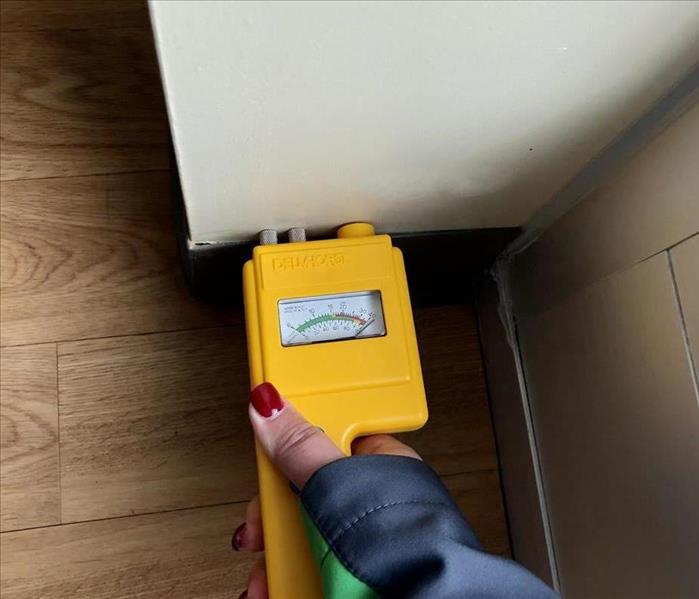 SERVPRO uses drying equipment and moisture meters to verify moisture content.
SERVPRO uses drying equipment and moisture meters to verify moisture content.
Do you know the science SERVPRO of Longview County uses to dry out your home or business?
Did you know there is actually a science behind the process of drying? The knowledge of psychrometrics is essential to restoring a water-damaged structure to its preloss condition. While your initial reaction may be to grab a few towels to mop up the mess and place a fan or two around the damaged area, SERVPRO of Longview Professionals are trained in the science of drying and follow strict industry-approved standards to help lower the chance of any secondary damages. If your business suffers from water damage, your local SERVPRO professionals will:
- Inspect the building to detect every component that is wet, to help prevent secondary damage from happening.
- Measure how much moisture is in wet materials and monitor whether those materials are drying
- Speed up Mother Nature by using professional drying equipment.
What exactly does “speed up Mother Nature” mean? A wet building can often dry naturally because the environment always seeks equilibrium. When materials are wet, moisture will naturally move to drier air at the surface of the material- but only if the air is, indeed, drier. The only problem is, that nature often takes too long, and secondary damages may occur while the building is drying out. For this reason, the professionals at SERVPRO have been trained to use top-of-the-line equipment to help Mother Nature along, including equipment to help dry hardwood floors, tough-to-reach spaces inside walls, and much more. SERVPRO of Longview also has state-of-the-art monitoring equipment and a proven scientific process to help speed the drying of your home or business.
The bottom line? Your local SERVPRO of Longview has the training and equipment to help make it “Like it never even happened.” Call us today at 903-238-8100.
Anytime is a good time for a deep residential cleaning, especially after a storm.
8/5/2022 (Permalink)
 Professional residential and commercial cleaning is provided by SERVPRO of Longview.
Professional residential and commercial cleaning is provided by SERVPRO of Longview.
Ceilings and Walls
Ceiling and wall cleaning should be part of the cleaning maintenance of your home or business. You should also clean the walls before painting so that the primer and paint can adhere properly. Whether you are preparing to paint or just looking for professional cleaning, SERVPRO of Lufkin/S. Nacogdoches County can help.
Ceilings and walls are exposed to dirt and dust, pet dander, cooking oils and grease, cigarette smoke, and other contaminants. Your heating and air conditioning system can distribute these contaminants throughout your property.
Using SERVPRO’s time-tested and industry-approved steps, along with our proprietary cleaning products and methods, we strive to restore your ceilings and walls without the need to repaint or refinish and to help the entire property smell fresh.
Hard Floors
Hard flooring, like hardwood and tile, is often used in today’s homes and commercial properties. At first glance, hard flooring appears to be easy to clean, maintain, and restore. However, these materials tend to have soil accumulate over time, and eventually, you’ll need professional cleaning to remove this buildup.
We have specialized training in time-tested and industry-approved cleaning methods. Also, our proprietary cleaning system allows our Professionals to properly clean and restore your floor’s original beauty.
Need Professional Cleaning? Call Today 903-238-8100
Faster to your Gregg County Storm Damage Event
8/5/2022 (Permalink)
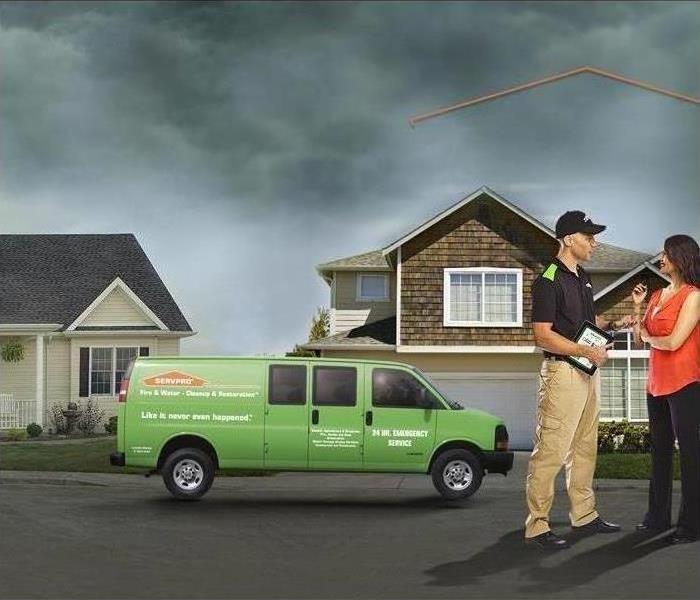 SERVPRO of Longview provides 24-hour fire and water damage restoration service in East Texas
SERVPRO of Longview provides 24-hour fire and water damage restoration service in East Texas
Flooding and water emergencies don’t wait for regular business hours and neither do we. SERVPRO of Lufkin/S. Nacogdoches County provides emergency cleaning and restoration services 24 hours a day, 7 days a week—including all holidays.
Faster To Any Size Disaster
Flooding and water damage are very invasive. Water quickly spreads throughout your home and gets absorbed into floors, walls, furniture, and more. SERVPRO of Lufkin/S. Nacogdoches County arrives quickly and starts the water extraction process almost immediately. This immediate response helps to minimize the damage and the cleaning and restoration costs.
Water Damage Timeline
Within Minutes
- Water quickly spreads throughout your property, saturating everything in its path.
- Water is absorbed into walls, floors, upholstery, and belongings.
- Furniture finishes may bleed, causing permanent staining on carpets.
- Photographs, books, and other paper goods start to swell and warp.
Hours 1-24:
- Drywall begins to swell and break down.
- Metal surfaces begin to tarnish.
- Furniture begins to swell and crack.
- Dyes and inks from cloth and paper goods spread and stain.
- A musty odor appears.
48 Hours to 1 Week:
- Mold and mildew may grow and spread.
- Doors, windows, and studs swell and warp.
- Metal begins to rust and corrode.
- Furniture warps and shows signs of mold.
- The paint begins to blister.
- Wood flooring swells and warps.
- Serious biohazard contamination is possible.
More Than 1 Week:
- Restoration time and cost increase dramatically; replacing contaminated materials and structural rebuilding may be extensive.
- Structural safety, mold growth, and biohazard contaminants pose serious risks to occupants
If You Need Help, Call Us Today – (903) 238-8100.
How to Protect Your Home During Summer Storm Season
7/4/2022 (Permalink)
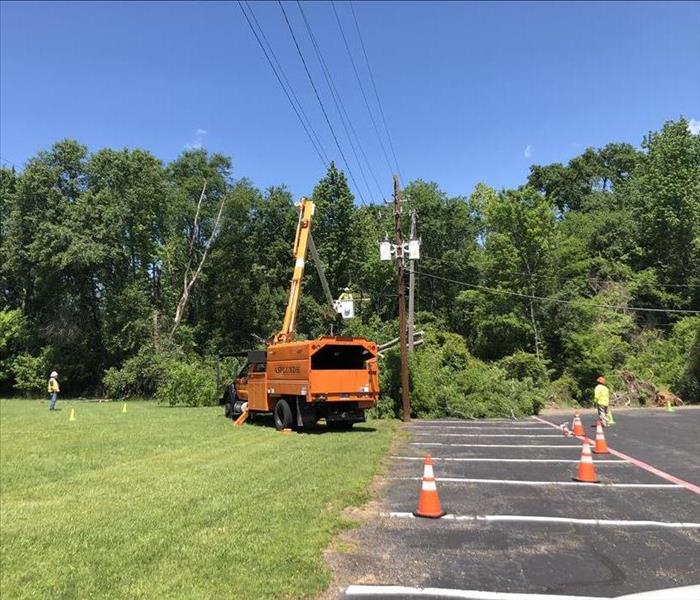 In the end, preparation and a calm head are hugely important. Stay safe!
In the end, preparation and a calm head are hugely important. Stay safe!
Summer may lead you to think of family vacations, school breaks, and sunshine but the season is about something else for many people – storms. Thunderstorms are a part of the American summer but they are also a dangerous part. Lightning results in 55 – 60 deaths and 300 injuries every year. Extreme weather can be harmful to both yourself and your home. So make sure to stay on top of all storm safety tips to stay afloat.
Beware of Lightning
If you’re outside and ever feel “tingly hair” or hear a buzzing sound, this means lightning is imminent. The safest thing to do here is crouch down on the balls of your feet making sure your shoes touch with your head down and ears covered. This will reduce the risk of you being hit and will minimize injury if the worst happens.
Although this will help protect you, you are still at high risk. Once the sensation passes, go inside as soon as you can. You are still in danger so do not go out unnecessarily and rely on this method to stay safe.
Failure to Prepare is Preparing to Fail
It’s essential to implement all storm safety tips before a storm arrives. You should always take notice of your local emergency warning system. This will advise you about any upcoming storms as well as their severity.
No matter how safe you think your home is, you will need to evacuate immediately if a warning to leave is issued. Not all storms however will require an evacuation. Sometimes, it is safer to stay inside. In the event of lightning, for example, you should remember the 30/30 rule and go inside if you cannot count to 30 before hearing thunder but not leave the house until 30 minutes after the last thunder-clap.
If it is safe for you to stay at home, here is a handy checklist of things to have:
- Nonperishable foods (think canned food, pasta, and even peanut butter! Make sure a tin opener is kept with these)
- Bottled water (approximately 1 gallon per day – have a supply for two weeks in stock)
- Flashlights (and batteries in case the ones in the flashlights run out)
- First Aid Kid (and all medicines that any family members may require)
- Waterproof Containers (make sure your important documents are not ruined by floods)
- Whistle (in case you need to signal for help)
It’s a good idea to store these all year round but when storm season is coming up, check you have everything so that you’re the most prepared you can be.
As well as stocking up on these essentials in advance, we recommend having a storm safety plan. Every school and workplace has an emergency plan so why not have one for your home too?
Make sure any children understand what to do and where to go in the event of a storm. To get their attention, you can have a roleplay to demonstrate safety procedures to children. We recommend having a designated safe meeting place in the home - you could even print out these tips and keep them there.
Exterior Maintenance
Part of having a storm safety plan in the home is removing the dangers that sit outside your home. Here are some of our top tips:
- Keep on top of yard maintenance (e.g. trim tree branches to limit breakages).
- Secure or remove any loose items from the yard. It may be summer but it is safer to take down and pack away play items such as slides, a swing frame or trampoline as well as outdoor ornaments.
- Make sure you don’t have any loose tiles as these could fall.
- Be mindful of your trashcan as you do not want garbage thrown across your lawn.
Braving the Storm
Once you’ve finished your preparations, it’s very important to stay calm when a storm actually hits. Keep a few basic storm safety precautions in mind. Some of the essential things to remember include:
- DON’T GO OUTSIDE! This should be an obvious storm safety tip; needless to say always wait until the storm has cleared and the local weather has announced that it is officially safe to do so.
- Stay away from windows – these could break at any moment.
- Steer clear of electrical wiring, particularly if there is water damage.
- Avoid taking a shower or bath – it is more important to stay safe than bathe.
After the Storm
Once the storm has settled, you still need to be aware of the dangers. When it’s officially safe to leave your house, stay alert and be careful of the hazards we’ve listed below:
- Never drive through a flooded roadway. Do not think “It will be OK” as you cannot predict how deep the water may be and may end up stranded.
- Keep clear of areas that have been hit badly by the storm. There is still the risk of falling debris.
- Continue to listen to NOAA Weather Radio or to local radio and television stations for updated information or instructions.
- Be aware of others. Remember to help people who may require special assistance, such as infants, children, and the elderly or disabled.
- Stay away from downed power lines and report them immediately.
- Watch your animals closely. Keep them in your control at all times. They are likely to have been distressed by the storm also.
In the end, preparation and a calm head are hugely important. Stay safe!
How To Prepare Your Trees Before A Storm
6/13/2022 (Permalink)
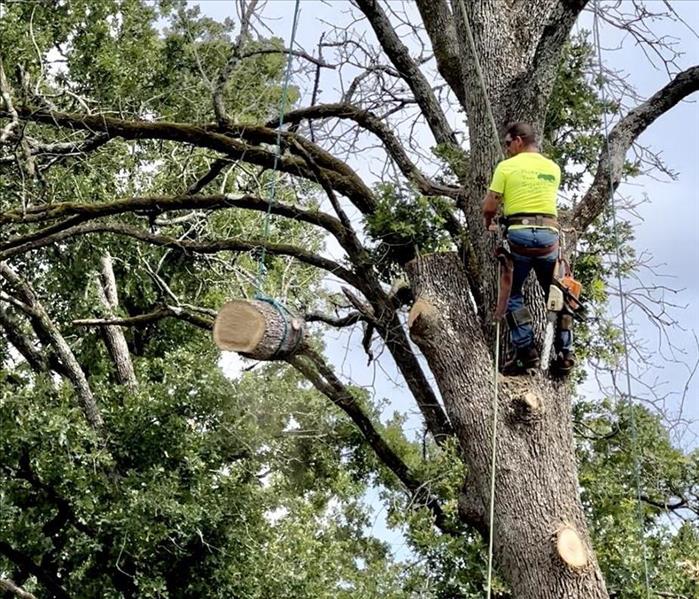 Removing dead trees and limbs prior to a storm can help save you from property damage.
Removing dead trees and limbs prior to a storm can help save you from property damage.
How To Prepare Your Trees Before A Storm
Hurricane season begins on June 1, and the intense summer storms could be right around the corner. Homeowners often overlook the importance of making sure their trees are prepared for severe weather, but it’s one of the most critical things you can do to ensure your home remains safe. From inspecting your yard to hiring a tree trimming service, here are some tips on to prepare your trees for a storm.
Inspect the trees on your property.
Begin by walking around your yard and taking note of the condition of your trees. Look at the bark, trunks, roots, branches, and canopies. Make sure you don’t see any obvious damage such as root rot, bare foliage, leaning trunks, insecure branches, or insect infestation. If anything looks amiss, contact a certified arborist, to come out and do a professional inspection.
Prune your trees.
Keeping your trees pruned regularly can greatly cut down on wind resistance which can damage trees. Pruning significantly reduces the chance of damage to your home in a storm, as it removes branches that are too close to your house as well as dead or weak branches that could fall during severe weather. It’s also important to properly prune the low branches of young trees to avoid having multiple leaders, which can cause instability. When trimming a tree becomes too large of a task to do on your own, a certified arborist should be called.
Take care of your trees year-round.
Taking good care of your trees year-round is always a good idea. Keeping trees healthy is the best way to protect them from damage during storms, and to protect your home. Check that they have enough water and fertilizer, and ensure that they have a sufficient amount of mulch at their base. Certain trees may require special care, so speak with a professional tree care service to see how you can best prepare them for severe weather.
Hire a certified arborist.
Well before a storm hits, call an ISA-certified arborist offering professional tree trimming. They are specially trained to recognize any illness or damage your trees may have and can help you address these hazards. Having one of these specialists inspect your trees is one of the best ways to assure that you are prepared for storms and hurricane season.
What Should You Do Before a Hurricane?
6/5/2022 (Permalink)
 SERVPRO franchises are always ready to help storm-damaged areas.
SERVPRO franchises are always ready to help storm-damaged areas.
What Should You Do Before a Hurricane?
Hurricanes are massive storm systems that form over ocean water and often move toward land. Hurricanes bring high winds, heavy rain, storm surge (rise in water level), flooding, and tornadoes. These storms are dangerous and can cause damage to places far inland. Prepare now so you can stay safe.
Make a Plan.
Hurricane season starts on May 15 in the north Pacific and June 1 in the Atlantic and the Caribbean. It ends on November 30. Before hurricane season each year, make sure you and your family are prepared by planning ahead.
Write down emergency phone numbers and keep them on the refrigerator or near every phone in your house. Program them into your cell phone too.
Prepare an emergency supply kit.
Locate the nearest shelter and different routes you can take to get there from your home. If shelter locations in your area have not been identified, learn how to find them in the event of a storm external icon.
Pet owners: Pre-identify shelters, a pet-friendly hotel, or an out-of-town friend or relative where you can take your pets in an evacuation. Local animal shelters may be able to offer advice on what to do with your pets if you are asked to evacuate your home.
Plan to Evacuate
If advised to evacuate, do so immediately and go to a safe place.
Know where you will go, how you will get there, and where you will stay.
Plan well in advance if you will need help leaving or using public transportation.
Mobile/manufactured/trailer homes and recreational vehicles (RVs) cannot provide safe shelter from tropical-storm or hurricane-force winds.
Plan to Shelter Safely
Be ready to live without power, water, gas, phone, and internet for a long time.
Practice going to a designated safe shelter for high winds. The next best protection is a small, interior, windowless room in a sturdy building on the lowest level that is not likely to flood.
If you are in an area that is likely to flood, designate a location on higher ground that you can move to before floodwaters reach you. Being informed of local weather conditions is the best way to help take care of your family and property.
SERVPRO Disaster Recovery
5/8/2022 (Permalink)
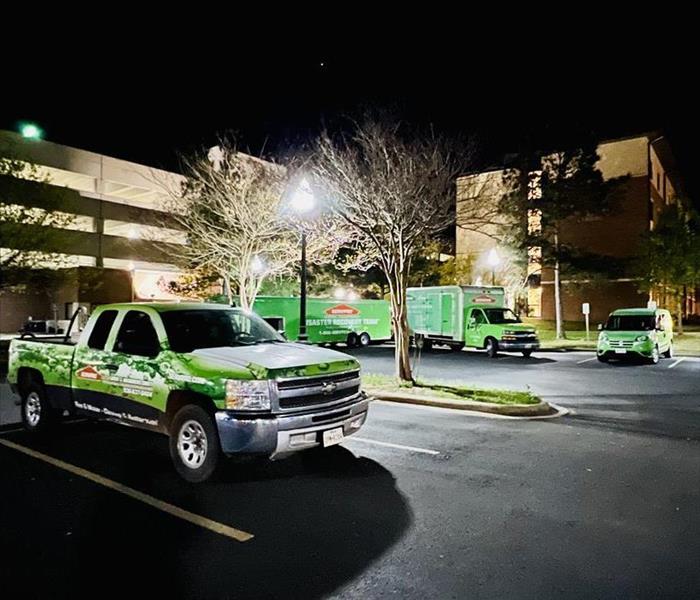 The SERVPRO Disaster Recovery Team was called out overnight to handle a major three-story water loss at a university
The SERVPRO Disaster Recovery Team was called out overnight to handle a major three-story water loss at a university
After the water begins to recede and authorities determine it is safe for residents to return to their property, there are several steps that can be taken to prevent additional damage from occurring. SERVPRO® suggests the following steps to help minimize additional damage to your property while waiting for disaster professionals to arrive.
- If the water has entered the structure through the flooding of a creek, stream, or river, or if it has filtered through insulation during its intrusion, it is considered to be black water and could be hazardous to your health. Avoid contact with contaminated items as much as possible.
- Take the greatest caution while entering your home, and wear sturdy shoes and protective clothing when dealing with flooded areas.
- Do not attempt to operate any electrical equipment while standing in wet or damp locations.
- Throw away all foods—even canned goods—that have come into contact with floodwaters.
- Remove and prop wet upholstery and pillow cushions for drying. Wipe excess water from wood furniture after removal of lamps and tabletop items.
- If your home has a crawlspace, be aware excess moisture in this area can often foster mold growth.
SERVPRO’s Disaster Recovery Team mobilizes from across the country, as needed, to support large storm events.
Faster to anysize disaster
8/2/2021 (Permalink)
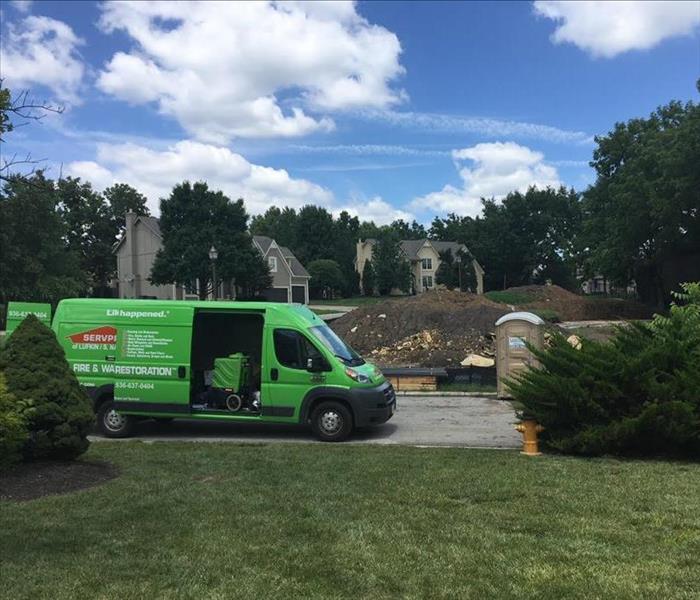 SERVPRO is Faster to Anysize Disaster anywhere in the Longview/Kilgore area with 24/7/365 Emergency Service!
SERVPRO is Faster to Anysize Disaster anywhere in the Longview/Kilgore area with 24/7/365 Emergency Service!
24 Hour Emergency Service
Flooding and water emergencies don’t wait for regular business hours. Many of our satisfied clients will tell you that. Storms don't take holidays off and neither do we. Here at SERVPRO of Longview, we pride ourselves on truly being faster to any size disaster. We are available 24 hours a day, 7 days a week, 365 days a year. When severe weather strikes in East Texas it doesn't just bring rain. Trees, sleet, and hail are all part of East Texas weather. Let us help you with your fire or water damage restoration emergency and we promise you won't regret it. Your home truly will be "Like it never even happened."
Need Emergency Service? Call Us 24/7 – (903) 238-8100
Faster to Any Size Emergency
In many cleaning and restoration situations, immediate action is needed. With over 1,700 U.S. and Canadian Franchise locations, SERVPRO is strategically positioned to be faster to any size emergency. An immediate response helps to minimize the damage and the cleaning and restoration costs.
Water is particularly invasive, quickly spreading throughout your property and being absorbed into floors, walls, furniture, etc. SERVPRO of Longview arrives quickly and starts the water extraction process almost immediately.
Can I repair water damage to my laminate flooring?
7/31/2021 (Permalink)
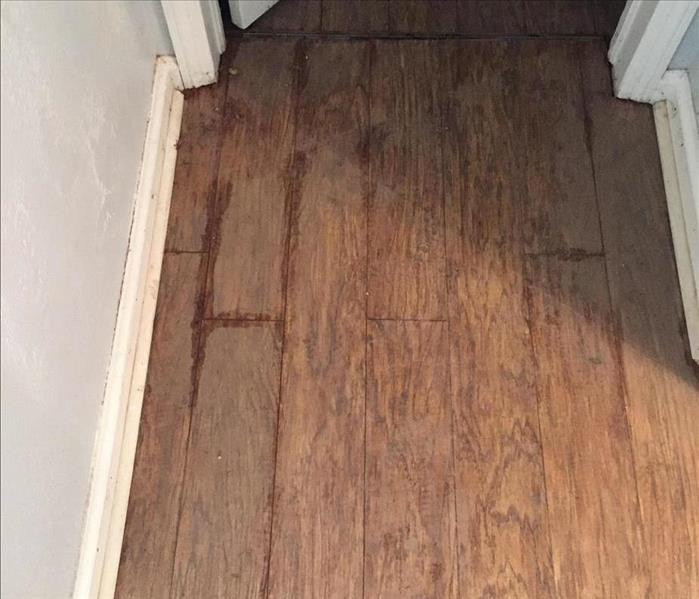 Repairing water damaged laminate flooring
Repairing water damaged laminate flooring
Laminate Flooring
According to Flooring America, laminate flooring has four layers: a cushioned bottom layer, a fiberboard core that is similar to particle board, a design layer above the core that gives your floor its color, and a top coating of aluminum oxide, known as the wear layer, which provides protection from fading, stains, and burns. The wear layer is constructed to protect against minor spilled water on a laminate floor as long as the spill is wiped up promptly.
How Damage Occurs
A laminate floor will not be damaged as long as it is not saturated with water. If you have a spill, it is best to promptly pat it dry with a sponge or a towel. It's when you have a large spill or a flood that the laminate flooring becomes saturated with water and damage occurs. Laminate flooring water damage pictures will show that damaged floors can swell, bend, buckle and crack.
What to Do
If your floor shows signs of water damage, there is little to do except replace the affected floorboards. Once the boards are water damaged, they can't be sanded or fixed in any other way. Even when the surface appears dry, the boards can still hold enough water that your laminate floor is bubbling at the seams. If the planks get so wet that they swell up, they will need to be replaced.
If you have Water or Flood Damage?
Call Us Today – (903) 238-8100
Use Sandbags to Help Fight Flooding
7/31/2021 (Permalink)
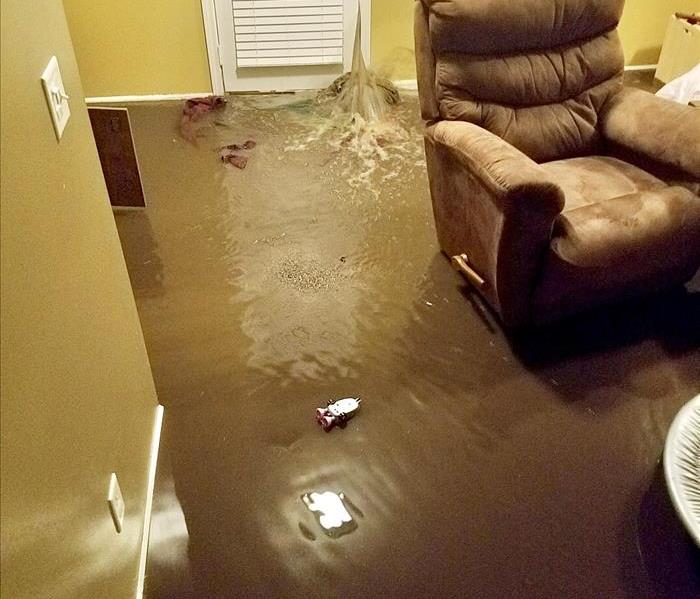 Use sandbags to help prevent rising water from getting into Kilgore, Texas your home or business.
Use sandbags to help prevent rising water from getting into Kilgore, Texas your home or business.
Flooding is the most common natural disaster in the United States. It can occur anywhere and at any time, not only near rivers and creeks but also after hurricanes or other heavy rainfall.
Sandbagging is a flood prevention technique that has been around for centuries. You can build a barrier with sandbags to help divert and stop water from getting inside vulnerable doors and around foundations. Sandbagging can be done with traditional sandbags, the most recognizable of which is burlap. There are also other products on the market, such as self-inflating bags, which act as flood barriers that are easier to maneuver, lift and place. Regardless of the type of bag you use, the same tips and techniques for placement apply.
The use of sandbags is a simple, but effective way to prevent or reduce flood water damage. Properly filled and placed sandbags can act as a barrier to divert moving water around, instead of through, buildings. Sandbag construction does not guarantee a water-tight seal but is satisfactory for use in most situations. Sandbags are also used successfully to prevent overtopping of streams with levees, and for training, current flows to specific areas.
Sandbag barriers can easily be constructed by two people, as most individuals have the physical capability to carry or drag a sandbag weighing approximately 30 pounds. Filling sandbags is a two-person operation and both people should be wearing gloves to protect their hands. Bags should be filled between one-third (1/3) to one-half (1/2) of their capacity. This keeps the bag from getting too heavy and permits the bags to be stacked with a good seal. Make sure to place the sandbags outside and against the doors where water enters your home.
Need Emergency Service? Call SERVPRO of Longview 24/7 – (903) 238-8100
Is Your Longview Home Storm Weather Ready?
7/26/2021 (Permalink)
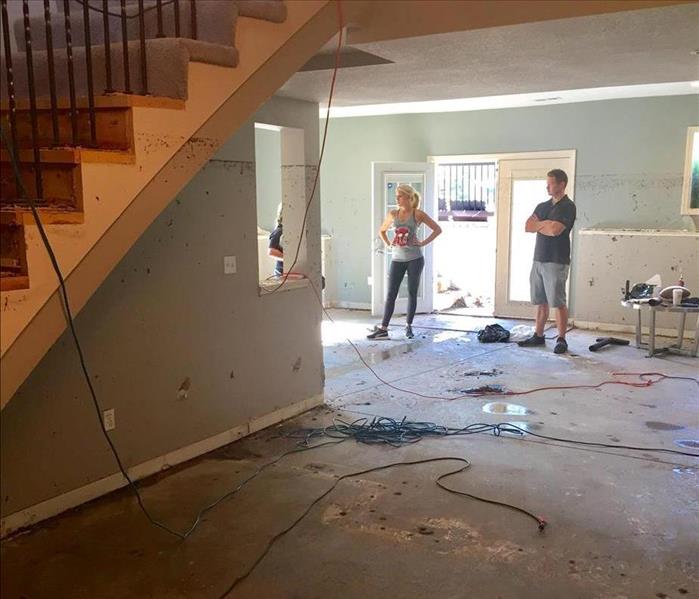 Unhappy Homeowners inspect their flood-damaged home
Unhappy Homeowners inspect their flood-damaged home
While Summer here in East Texas brings us lots of sunshine and pleasantly warm weather, it also gives us a fair share of storms. With storm season going all the way through late November, it's important to get your property prepared.
Here are a few tips to make your property more secure during a storm:
Get your roof and foundation checked out. Are there any cracks in your roof? If so, call a professional to have it repaired ASAP.
Remove any tree branches that pose risk to breaking a window, for example. Getting a tree trimming before the summer storm season begins is a wise idea.
Invest in storm windows.
Bring all patio furniture, grills, etc. indoors before the storm hits.
Tightly secure outdoor items you cannot bring indoors.
Bring potted plants inside until the storm passes over.
If you have a garage, park your vehicle inside it before the storm hits.
If you must evacuate due to the storm, secure and board up windows.
We hope you find these tips helpful and wish you an enjoyable and safe summer!
SERVPRO of Longview is a full-service restoration company that specializes in the cleanup, restoration & reconstruction of residential and commercial property after a fire, smoke, or water damage. We also mitigate mold & mildew, and biohazards from your home or business. Call us 24/7 at (903) 238-8100 and let us help make it "Like it never even happened."
Have Storm or Flood Damage in Kilgore, Texas? Call Us Today (903) 238-8100
7/20/2021 (Permalink)
 Have Storm or Flood Damage in Kilgore, Texas?
Call Us Today (903) 238-8100
Have Storm or Flood Damage in Kilgore, Texas?
Call Us Today (903) 238-8100
East Texas is no stranger to the ever-changing and sometimes damaging weather. A typical day in Longview may start off with beautiful warm friendly skies and by day's end have changed to heavy winds and threatening wind and rain. Have no fear, you have a friend in the business. Your local SERVPRO team has the right experience and training to handle all that Mother Nature may bring. Our team has helped with Disaster Recovery in 30 other states here in the U.S. We have helped literally hundreds of people when their homes or business have been impacted by: Fire, Water, Rain, Flash Floods, Strong Winds, Tornadoes, Wildfires or Hurricanes. We want our customers to know that we have seen just about everything Mother Nature can do and want you to know that help is just a phone call away.
Our storm team and equipment are standing by to make your property “Like it never even happened.”
Have Storm or Flood Damage?
Call Us Today (903) 238-8100
Flash Floods Can Develop Quickly In Longview, Texas.
7/9/2021 (Permalink)
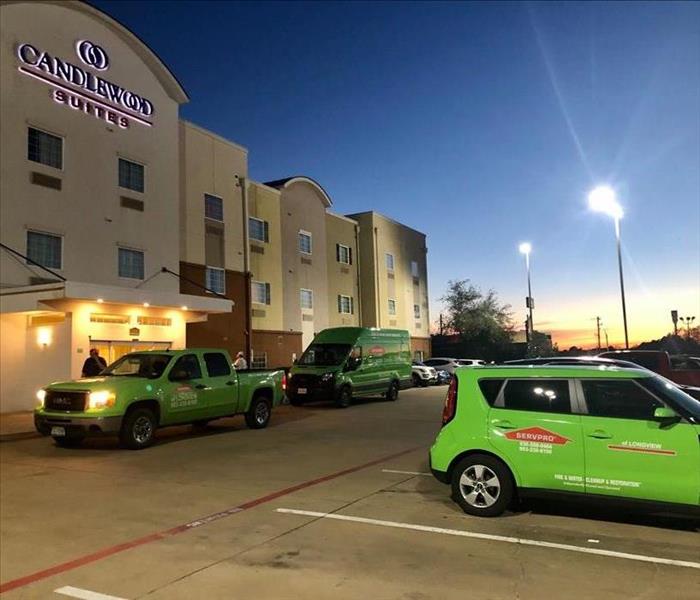 Flash Floods Can Develop Quickly In Longview, Texas.
Flash Floods Can Develop Quickly In Longview, Texas.
When driving:
- Avoid low water crossings.
- Use alternate routes to avoid flood-prone areas.
- Leave your vehicle immediately if it stalls in floodwaters.
- Move to higher ground if you can do so safely.
- Most cars and light trucks will begin to float in as little as 12 inches of water.
- Act quickly, rising waters make vehicle doors difficult to open.If you are outside:
- Everyone, especially children, should stay away from flooded creeks, streams, or drainage ditches.
- Swiftly flowing water can quickly sweep away even the strongest swimmers.
- Soggy banks can collapse, dumping you into floodwaters.
What types of water damage are covered by insurance?
7/9/2021 (Permalink)
 What types of water damage are covered by insurance?
What types of water damage are covered by insurance?
What types of water damage are covered by insurance?
Water damage is a common problem in homes, and it can be caused by a variety of issues. However, there are only a handful of water damage scenarios that will be fully covered by your homeowner's insurance. These types of water damage include:
- Sudden or accidental water discharge
- Storm-related water damage
- Accidental sewer backup or overflow (you may need an endorsement)
- Flood damage (if you have flood insurance)
Homeowner's insurance will only cover water leaks and water damage if the cause is sudden or accidental. For example, if a pipe bursts out of nowhere, the damage will likely be covered by your insurance policy. Gradual water damage, which occurs slowly and over time, is not covered by homeowners insurance.
Additionally, some homeowners insurance policies will cover resulting damages from water leaks. Resulting damages occur because of the initial damage. For instance, if a pipe bursts and the water damage destroys a nearby wall, you might be able to get reimbursed for the cost of repairing the wall.
However, not every homeowner's insurance policy covers resulting damage, so check your policy’s wording to see exactly what is included. If the resulting damage is covered, keep in mind that it will not extend coverage to sources of the water leak. So if a pipe burst and caused resulting damage, the cost of a replacement pipe wouldn’t necessarily be covered.
Always check with your insurance carrier with any coverage questions or concerns.
Is Your Longview Property Storm Ready?
7/1/2021 (Permalink)
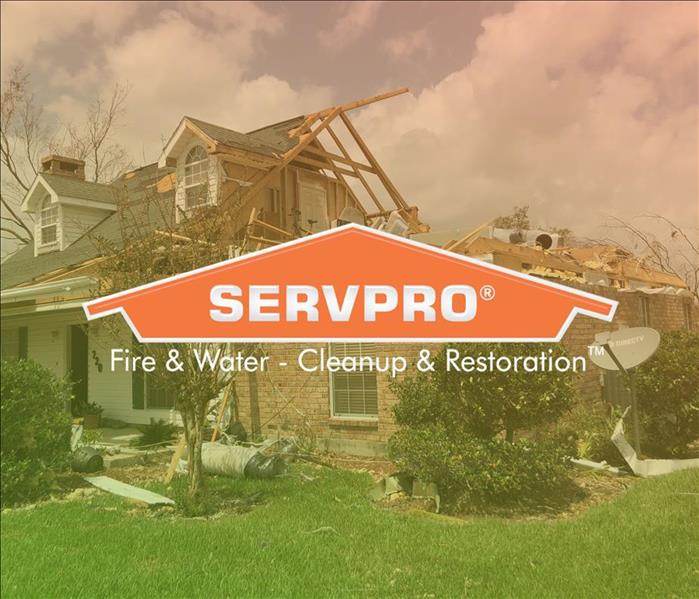 You can’t stop a tropical storm from affecting your Longview home, but you definitely can take steps to better protect you and your family.
You can’t stop a tropical storm from affecting your Longview home, but you definitely can take steps to better protect you and your family.
Hurricane season is already knocking on Texas’ door, are you ready?
You can’t stop a tropical storm from affecting your Longview home, but you definitely can take steps to better protect your family and your property from one.
Hurricane season starts on June 1st for us Texans and lasts all the way through November 30th. Typically, the season peaks right around the end of August and beginning of September, but heavy weather can still strike at any time. Hurricanes don’t only affect the people living on the shore however, their effects can be felt hundreds of miles away.
A Good Outline for a Plan:
- Write down emergency phone numbers and keep them on the refrigerator or near every phone in your house. Program them into your cell phone too.
- Prepare an emergency supply kit.
- Locate the nearest shelter and different routes you can take to get there from your home. If shelter locations in your area have not been identified, learn how to find them in the event of a storm.
- Pet owners: Pre-identify shelters, a pet-friendly hotel, or an out-of-town friend or relative where you can take your pets in an evacuation. Local animal shelters may be able to offer advice on what to do with your pets if you are asked to evacuate your home.
During and after a hurricane, you may need supplies to keep your family safe and healthy. Remember that a hurricane could cut off your power and water supply. You also may not be able to drive because of damage to your car. Roads may be flooded or blocked.
That’s why it’s best to be prepared and stock up on everything you might need now. Be sure to prepare the following:
Info from cdc.gov
Is Your Longview Property Ready for a Power Outage?
6/3/2021 (Permalink)
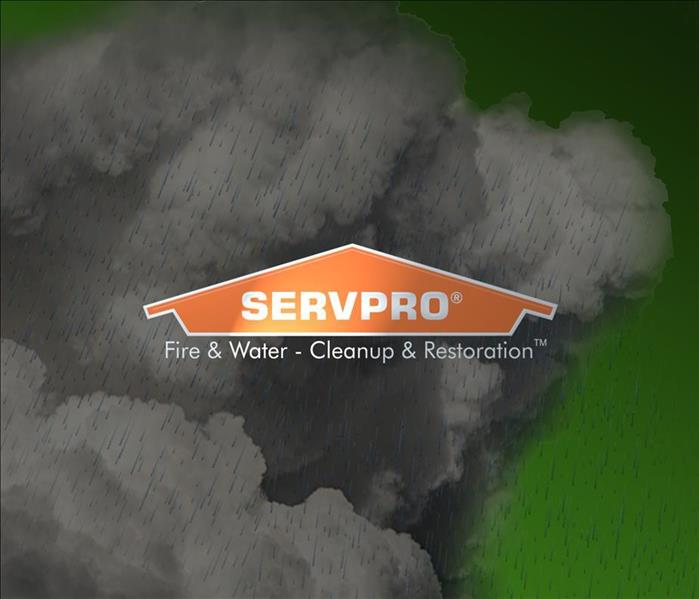 You can't stop a storm or power outage from affecting your home, but you can prepare. Make an Emergency Plan today.
You can't stop a storm or power outage from affecting your home, but you can prepare. Make an Emergency Plan today.
In the first half of 2021the Longview area has experienced a great deal of extreme weather. For the first time in decades, Texas became was hit by a formidable “Snow-Mageddon” which brought heavy snowfall and ice. Beyond that, we have had a large number of thunderstorms as well. These Snowfall and lighting storms were often accompanied by power outages, which often went on for days at a time. This all led to a mad dash for many people to buy supplies and generators, which showed a great lack of planning for a surprisingly large number of residents of Gregg County. So, here are some helpful tips and a good outline on how to prepare for a power outage.
If the lights go out and you’re left in complete darkness, navigate around your home carefully to avoid tripping over obstacles or knocking things off shelves. You do not want to clean up broken glass in the dark. Similarly, if the lights go out when you’re in the shower, do your best to rinse off any remaining soap and tread carefully while you find clothes. If you know you have a lot of tripping hazards around your home, put on shoes or slippers to avoid stubbing your toes or stepping on wayward toys.
Peek out the window to see if your neighbors have power. If they don’t, you may be without power a little while as the utility company works to restore it. During storms or strong winds, stay inside. Downed power lines are a significant threat if they’re still live. Immediately call your local utility if you see something that could be hazardous like sparks flying from power lines or downed poles.
Walk through your home, turning all your light switches to the off position. Unplug any appliances and electronics to prevent damage from electrical surges. Make sure you at least unplug your media center, any computers, and other expensive equipment. Leave one light switch on to signal when the power comes back on.
If you have a generator, keep it away from windows and never run it indoors. Likewise, never use camp stoves or charcoal grills inside your home. Without proper ventilation, carbon monoxide from combustion can get trapped in your home and put you at risk for carbon monoxide poisoning.
Keep a few flashlights within reach in the most used rooms in your home. Some good spots are near the front door, in the kitchen, and next to your bed. Make sure they have fresh batteries, and you have a supply of extras on hand as well. Be cautious using candles on surfaces that won’t budge like kitchen and bathroom counters.
A battery-powered or hand-crank radio is an essential tool for emergency preparedness. If you can’t charge your devices or connect to regular communication channels, a radio will tune you into weather and emergency updates in your area. Look for NOAA Weather Radios, which connect you to the National Oceanic & Atmospheric Administration’s 24-hour national weather service.
During emergencies, especially in extreme weather, your home’s water supply could be at risk of contamination from sewage or flood waters. Safe drinking water is the first essential to make sure you have on hand. Make sure you have enough water for everyone in your household. It’s recommended to have at least one gallon per person, per day for at least three days. For a family of four, that’s a minimum of 12 gallons of drinking water.
Food is also a critical concern during longer power outages and emergencies. To keep your perishable foods (meat, poultry, fish, eggs, or leftovers) fresh as long as possible, avoid opening your fridge and letting out any more cold air than is absolutely necessary. Even without power, refrigerators will keep your food cold for roughly four hours. A full freezer will stay cold for about 48 hours.
Info from: justenergy.com
What Exactly are Thunderstorms?
6/3/2021 (Permalink)
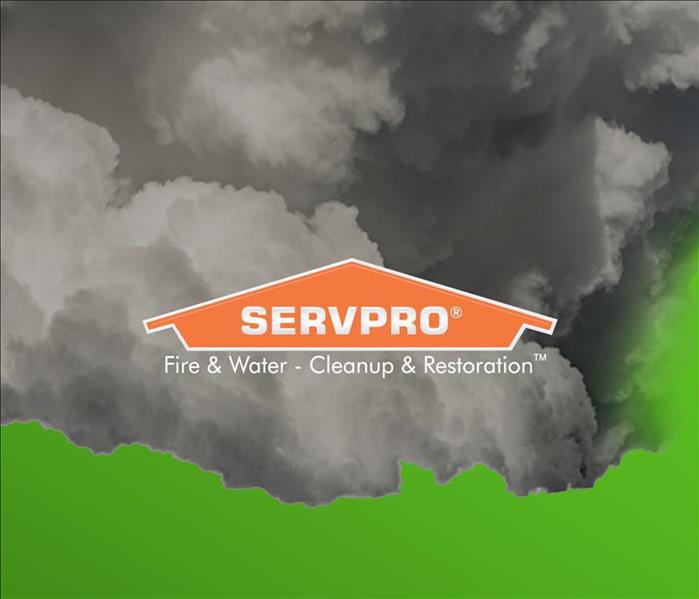 In the unfortunate event a thunderstorm or other natural disaster has affected your home our business, give us a call at: 903-238-8100
In the unfortunate event a thunderstorm or other natural disaster has affected your home our business, give us a call at: 903-238-8100
Longview, along with other surrounding areas of East Texas, are no strangers to thunderstorms. Severe and quickly changing weather is the norm around our parts for sure, but what exactly is the reason for that? Well, I thought it would be helpful to understand a little more about the entire thunderstorm process, and more importantly how to better prepare for them.
Thunderstorms- What Causes Them?
According to the National Severe Storms Laboratory, three basic ingredients are required for a thunderstorm to form:
- Moisture
- Rising, Unstable Air
- A Lifting Mechanism
The process of thunderstorm formation begins with the sun heating the surface of the Earth. This, in turn, heats the air just above the Earth’s surface. Because warm air is less dense than cool air, warm air will begin to rise. As this rising warm air interacts with various elements of the Earth’s surface terrain (hills, mountains, or pockets of cooler air) it continues to be pushed higher into the atmosphere. As this air reaches the cooler areas of the atmosphere, it also begins to cool, allowing the moisture contained within to condense, beginning cloud formation. As more particles of continuously cooling moisture gather, they begin to “bounce off of” one another within the cloud. These collisions eventually build up large reactions of electric charge, resulting in lightning, which creates the soundwave we know as thunder.
Thunderstorms – How to Prepare?
Thunderstorms are most likely to occur in spring and summer months, when the surface of the Earth reaches higher temperatures, but can take place at any time of the year.
- Keep your roof gutters cleared, especially in the spring and summer months. Debris in gutters can cause rainwater to back up onto your roof, which can result in property damage.
- Follow your local weather forecast. Although many thunderstorms can occur quickly, it is important to be weather aware when living in a region prone to thunderstorms.
- Since lighting is one of the most dangerous components of a thunderstorm, be sure to practice lightning safety: during a thunderstorm, stay away from windows and doors, avoid using electronic devices that are connected to the wall, and avoid using plumbing, as metal pipes can conduct electricity.
SERVPRO of Longview values the safety of our community members as well as their properties. In the unfortunate event a thunderstorm or other natural disaster has affected your home our business, give us a call at 903-238-8100, We’re Here to Help!
Info from:
https://www.nssl.noaa.gov/education/svrwx101/thunderstorms/
Tips From The National Weather Service on Strong Winds
5/1/2021 (Permalink)
 Heavy winds bring down trees
Heavy winds bring down trees
The National Weather Service alerts the public about high wind events using the following criteria:
- High Wind Warning: Take Action! Sustained, strong winds with even stronger gusts are happening. Seek shelter. If you are driving, keep both hands on the wheels and slow down. NWS offices issue this product based on local criteria.
- High Wind Watch: Be Prepared! Sustained, strong winds are possible. Secure loose outdoor items and adjust plans as necessary so you're not caught outside. NWS offices issue this product based on local criteria.
- Wind Advisory: Take Action! Strong winds are occurring but are not so strong as to warrant a High Wind Warning. Objects that are outdoors should be secured and caution should be taken if driving. NWS offices issue this product based on local criteria.
All it takes is a tree branch at 50 mph to shatter windows and 100 mph to penetrate exterior walls. Proper planning may help to save property and potentially people from injury and inconvenience when severe weather strikes.
Tips to prepare for heavy winds:
- Bring in unsecured objects from patios and balconies, and secure outdoor objects such as lawn furniture or garbage cans that could blow away and cause damage or injury.
- Move vehicles to garages or away from trees
- Check trees and branches for any that could break off during a storm and have them removed
- Secure and shut off your outdoor pool. Turn off the circuit breaker to your outdoor pool and remove the motor to prevent damage.
- Have an emergency kit prepared in case of a power outage with items like flashlights, batteries, weather radio, etc.
Does Melting Snow cause Flooding?
5/1/2021 (Permalink)
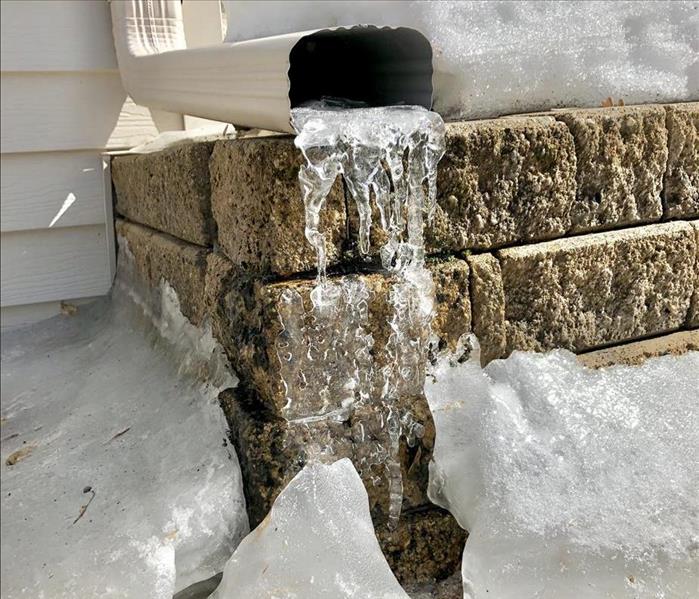 What happens when snow melts?
What happens when snow melts?
How to Prevent Snowmelt Flooding
- Shovel snow away from your home, keeping it away from your foundation. Whenever possible, keep snow 5 feet away from your foundation.
- If your home is on a grade or hill, shovel snow so that it doesn’t roll toward your home when it melts. This ensures melting snow flows away from your home, instead of towards it.
- Clear snow from your roof to prevent excessive buildups. This prevents a significant amount of water flowing through your gutters during a thaw.
- Keep drainage areas around your home clear of snow and ice build-up. This ensures melting snow will drain properly and helps prevent backups.
- Inspect basement walls for cracks. This includes caulking around windows too. Make repairs as necessary to prevent water from entering your basement.
- Check your landscaping before the snow arrives to ensure the ground slopes away from your home. Add additional soil if necessary to help melting snow flow away from your foundation.
- Check your roof for ice and snow build-up. This can lead to ice damages that allow melting snow to enter through your roof.
- Inspect your gutters and downspouts. Clear leaves and other debris regularly during the fall, as this can create blockages. Add downspout extensions to channel melting snow away from your home.
- Check for and clear ice dams hanging from gutters. This places them directly over the perimeter of the home's foundation, meaning that when they melt, they could lead to an increased flooding threat in the basement.
- Test your sump pump during the winter to ensure it works properly when the snow melts. Pour a bucket of water into the sump basin to engage the pump. If it doesn’t turn on, unplug the pump and investigate the issue.
- Never ignore water in your basement. Investigate and repair the source as soon as possible.
- If you have water in your basement or a flood from melting snow, dry and clean the area as quickly as possible.
The Storm Damage Experts in East Texas
7/15/2020 (Permalink)
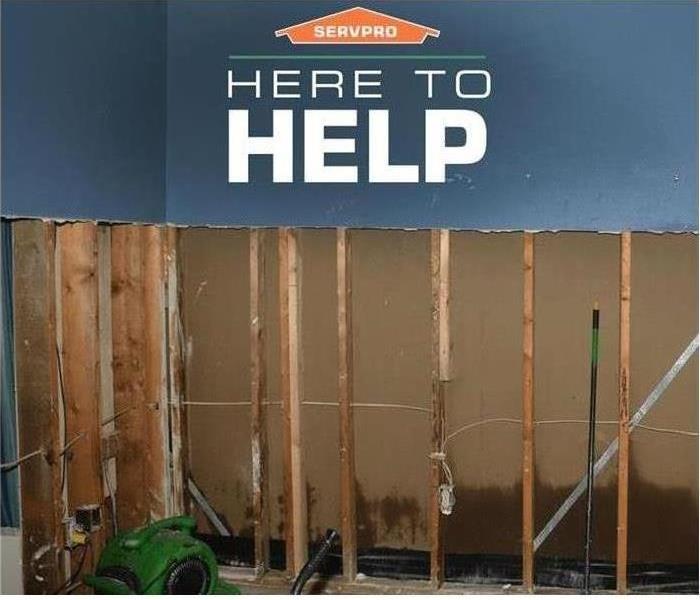
When heavy rains and high winds hit hard, property destruction and loss can be devastating to you as a homeowner. Structural damage to the exterior of your home is followed by interior devastation from water and winds. Storm damage is rarely isolated to just a few buildings in an area adding the challenge of finding a restoration company that can respond swiftly to your needs to an already anxiety provoking situation. SERVPRO delivers the help you need swiftly even when a local disaster is widespread as we are able to call upon a network of over 1,650 franchises nationwide to respond if the need is great.
Storm damage can feel overwhelming, but your fear and panic will disappear when our team of professionals responds to your water, wind and flooding repair and restoration needs. Your particular situation is of paramount importance to us, and you need not worry that your repairs and restoration will take a back seat even when many in your area are struggling to recover from the same issues you face. Choosing our company puts in motion a vast support system, but our local ownership means you will receive a personalized approach to your particular situation, efficiently returning your home back to its pre-storm condition just “Like it never even happened.”
Placing your trust in SERVPRO for your storm damage needs will reap you benefits that less qualified companies simply cannot deliver. We use state of the art equipment to clean, repair and restore your home and in the process, we also restore your and your family’s peace of mind. Our technicians are highly trained for any procedure needed to bring your home back to the comfortable and comforting refuge you deserve. We also work closely with your insurance company, ensuring that all the work necessary is approved and compensated according to the terms of your policy. Our high standards and relentless drive to do the job on time while meeting local specifications means you and your family will quickly return to the quiet enjoyment of your house and neighborhood. We are not satisfied until you are happily back in your restored dwelling.
We are here for you 24 hours a day, 7 days a week! Call 903-283-8100.
SERVPRO of Longview is always storm ready!
7/7/2020 (Permalink)
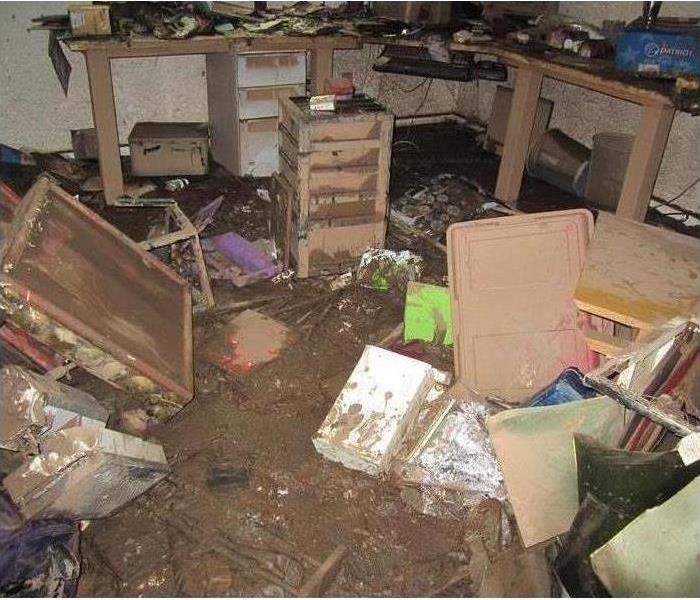 Our highly trained crews are ready to respond 24/7 to storm or flood damage in East Texas.
Our highly trained crews are ready to respond 24/7 to storm or flood damage in East Texas.
SERVPRO of Longview specializes in storm and flood damage restoration. Our crews are highly trained and we use specialized equipment to restore your property to its pre-storm condition.
Faster Response
Since we are locally owned and operated, we are able to respond quicker with the right resources, which is extremely important. A fast response lessens the damage, limits further damage, and reduces the restoration cost.
Resources to Handle Floods and Storms
When storms hit East Texas, we can scale our resources to handle a large storm or flooding disaster. We can access equipment and personnel from a network of 1,800 Franchises across the country and elite Disaster Recovery Teams that are strategically located throughout the United States.
Have Storm or Flood Damage? Call Us Today (903)238-8100
Summer Storms in East Texas
6/11/2020 (Permalink)
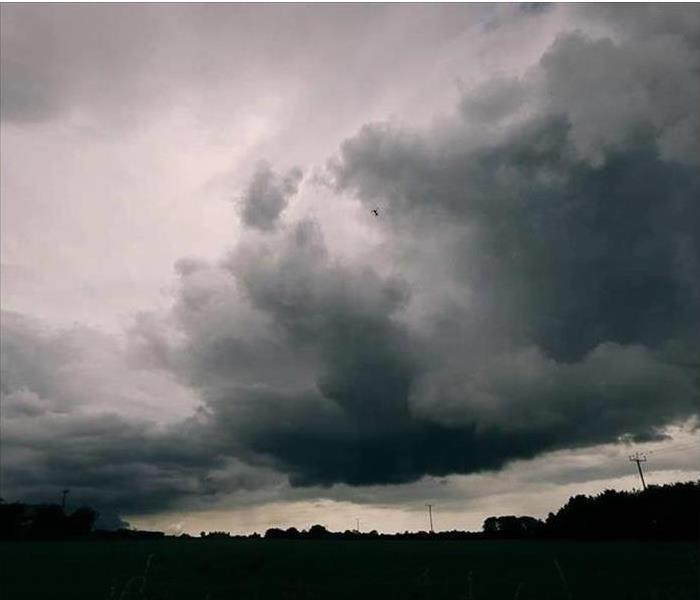 Always have a plan for storms.
Always have a plan for storms.
Summer comes with many fun things BBQ’s, swimming at the beach, camping and spending time with family. Summer seasons can also come with wind, rain, and thunder/ lightning storms. When heavy rains come we risk floods, and high winds can wreak havoc on the power lines and trees around your home.
Here are a few help tips to keep your home safe during the summer months:
- Have an emergency kit ready in your home including these items: flashlight, battery powered radio, extra batteries, canned and dry foods, water, can opener, first aid, fire extinguisher, blankets, extra clothes and shoes, flares or whistle to signal for help.
- Cut down any dead or unwanted trees and branches around your home.
- Know the safest structure of your home to go during a severe storm, make sure everyone in your household knows to meet here.
- Avoid electrical equipment and telephones, instead use your battery powered TVs and radios.
If you happen to be caught outside during a thunder storm:
- Never take shelter under a tree or tower, lighting tends to strike the tallest object in the area
- Leave if you’re in an elevated area such as on a hill, mountain or peak
- Get out and away from any body of water
- Stay away from anything that conducts electricity including wires and fences.
If your home is affected by a summer storm don’t hesitate to call SERVPRO of Longview 24 hours a day, 7 days a week at 903-238-8100. We are here to help!
Steps to take during a Power Outage
6/8/2020 (Permalink)
We’re more vulnerable to power outages this time of year because of new growth and leaves that are still on the trees, which can pull branches down. Ready, a national public service advertising campaign, gives us these tips to follow before, during, and after a power outage.
Before
- Build or restock your emergency preparedness kit, including a flashlight, batteries, cash, and first aid supplies.
- Make sure you have alternate charging methods for your phone or any device that requires power.
- Charge cell phones and any battery powered devices
- Know where the manual release lever of your electric garage door opener is located and how to operate it.
- Purchase ice or freeze water-filled plastic containers to help keep food cold during a temporary power outage.
- Keep your car’s gas tank full. Gas stations rely on electricity to power their pumps,. If you use your car to re-charge devices, do NOT keep the car running in a garage, partially enclosed space, or close to a home, this can lead to carbon monoxide poisoning.
- Learn about the emergency plans that have been established in your area by visiting your state’s or local website so you can locate the closest cooling and warming shelters.
- If you rely on anything that is battery-operated or power dependent like a medical device, determine a back-up plan.
During
- Only use flashlights for emergency lighting, candles can cause fires.
- Keep refrigerator and freezer doors closed. Most food requiring refrigeration can be kept safely in a closed refrigerator for several hours. An unopened refrigerator will keep food cold for about 4 hours. A full freezer will keep the temperature for about 48 hours.
- Put on layers of warm clothing if it is cold outside. Never burn charcoal for heating or cooking indoors. Never use your oven as a source of heat. If the power may be out for a prolonged period, plan to go to another location that has heat to keep warm.
- Turn off or disconnect appliances and other equipment in case of a momentary power “surge” that can damage computers and other devices. Consider adding surge protectors.
- If you are considering purchasing a generator for you home, consult an electrician or engineer before purchasing and installing.
- Only use generators away from your home and NEVER run a generator inside a home or garage, or connect it to your home’s electrical system.
After
- Throw away any food that has been exposed to temperatures 40 degrees Fahrenheit (4 degrees Celsius) for 2 hours or more or that has an unusual odor, color, or texture. When in doubt, throw it out!
- If food in the freezer is colder than 40 degree Fahrenheit and has ice crystals on it, you can refreeze it
- Contact your doctor if you’re concerned about medications having spoiled.
- Restock your emergency kit with fresh batteries, canned foods, and other supplies.
SERVPRO of Longview’s main priority this season is safety. For any water or fire damage needs, feel free to call us at 903-238-8100
Protecting the Windows of your Home during a Storm
6/4/2020 (Permalink)
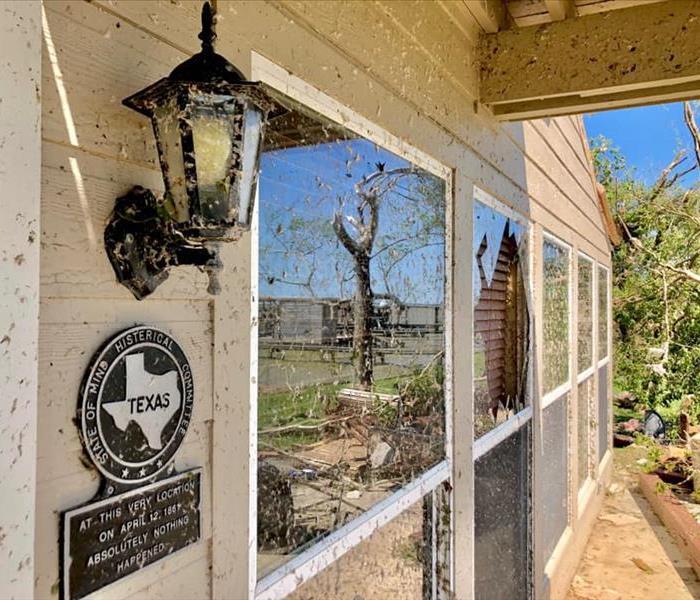 Protecting the Windows of your Home during a Storm
Protecting the Windows of your Home during a Storm
Some homes in Longview, Texas may be especially susceptible to high winds. However, you don’t have to sacrifice style and comfort to prevent windblown glass and exposure to the elements. Examine the following shutter designs to choose the best one for your home.
1. Traditional Designs
When many people picture shutters, they imagine a wooden frame on either side of the window with rows of slats. This is called the colonial design, and it is so common that many homes use a non-functional version as a decorative window accent. However, depending on the conditions in your area, the colonial shutter variety might be a solid choice for storm protection as well. Another traditional design called the Bahama shutter has vertical hinges, allowing it to open into a small awning to provide shade in warmer climates.
2. Modern Equipment
Other homeowners choose a sleek and compact look to keep their shutters out of the way when no high winds are present. Accordion and rolling shutters are made of light metals or polycarbonate, giving them a high degree of strength and flexibility. This enables the window cover to fold away or roll up when not in use. These designs are typically more expensive than the traditional varieties, and can even be electrically-powered for added convenience.
3. Temporary Protection
Storm panels and plywood are another window damage prevention method for those in high-risk locations. These storm shutters are not intended for permanent installation, and properly speaking, they do not “shut” over the window at all. Storm panels are corrugated metal surfaces that are simply affixed to the window frame with screws. Plywood is an even cheaper solution and can be implemented faster, but may not be as secure.
Whatever shutter option you choose, remember that protecting your home against high winds is the first step toward avoiding interior flooding. Have the contact information of a qualified water damage restoration service ready if you anticipate severe weather conditions.
Now is a great time to check your gutters!
6/4/2020 (Permalink)
 Now is a great time to check your gutters!
Now is a great time to check your gutters!
Did you know that a large percentage of damage homes suffer during a rain storm or hurricane is to the roof? Keeping your gutters clear and in good condition can help reduce the amount of damage your roof receives and how much water seeps into your home. The more prepared your are, the less damage you will have to face.
Here are some tips on how to prepare your roof gutters before a rain storm/hurricane:
- Get out your ladder. Go around your house and make sure your gutters are free of leaves and debris. This is a top tip from every government agency and safety service. By late fall, it’s likely more than half full of leaves that have fallen and they’ve clogged your gutters. Add a lot of rain, and it’s a receipt for water in your basement, leaky ceilings, and more.
- Extend you downspouts. Keeping water away from your foundation is critical when there is a lot of rain. A downspout that only extends the length of the curve can be dangerous. Even one that extends three feet isn’t good enough. Downspout extenders or even length of downspout attached to the downspout elbow can keep the ground around your home from getting over saturated. Water can seep through the walls of your foundation if the ground gets too wet.
- Check your window wells. Cover them if you can keep out excess water and debris. If a gutter were to clog, it’s often a window well that fills with water first. The seals around the windows won’t keep water from pouring into your home. Keep a bucket handy and check your window wells often during the storm. A little preemptive bailing can keep from a wet basement.
- Be courteous and don’t dump your leaves in the street. After gutter cleaning, you may want to dump all those leaves out to the street for pick up. Do your street storm drains a big help by not dumping them out there just yet. You’ll wind up putting a strain on local resources and services that, in a situation like this, should be going to more important issues. Storm drains will clog if the streets are taxed with extra leaves. They also make it more difficult to get to power lines or downed trees.
- Protect stuff in your basement. If there are places around your home prone to flood occasionally, even if you have dealt with your gutters before the storm, make sure you get them off of the ground.
Water damage after the storm can be devastating. Don’t hesitate to call SERVPRO of Longview 24 hours a day, 7 days a week at 903-238-8100.
Tornado Damage and Your Home
5/12/2020 (Permalink)
Tornadoes are a terrifying, often devastating, weather event. They can turn houses into dust, and flip lives upside down. Living through a tornado can be traumatizing, and sometimes the aftermath is just as bad. Parts of your home may be destroyed, and the idea of fixing it can be overwhelming. Recovering from a tornado could be a huge task, depending on how bad the damage was. However, there are steps to take toward recovery and people ready to help along the way. There are steps that should be taken right after the storm passes, and other steps to take down the road when it is time for repairs and cleaning.
Protect Yourself and Your Loved Ones
The first step is to stay in your safe place until the storm has completely passed. If you are able, try and wait until you get the all clear from local officials. After the storm, check yourself and those with you for any injuries. If someone is hurt, the next step is seeking out first aid. After everyone has been checked and is okay, you should see how bad the damage to your house is. Make sure to watch out for anything that is unstable and likely to fall. If you go outside, look out for any downed powerlines. They can be life threatening, so if you see downed powerlines stay inside.
Protect Your Property
After you make sure yourself and your loved ones are protected, start protecting your property. You can make temporary repairs in order to prevent further damage. Many insurance companies will reimburse you for the cost, so make sure to keep receipts just in case. In addition to temporary repairs, living expenses may also be reimbursable. If your house is damaged to the point of you having to stay in a hotel, keep the receipts. Your policy may pay you back for the cost of it. Make sure to make a list of anything that was damaged, and don’t throw out damaged belongings. An adjuster will need to assess them for value if your policy covers replacing them. You should also inspect all utility lines and appliances. Any damage could lead to a gas leak or electric shortage. Damaged electric wires may also cause a fire. You may even have to turn off the main valve in order to prevent more harm to your house. Once these steps have been taken, contact your insurance company. From there, they can work with you to see what your policy covers. Most of the time, they will hire services to come out and repair damages.
Clean Up and Repair
SERVPRO of Longview has an incredibly fast response time when it comes to disasters. We have equipment and personnel ranging across 1,700 franchises. Our experience and training will allow us to restore your property quickly and efficiently. In addition, we will document the entire process.
The Need for an Emergency Plan in East Texas
5/12/2020 (Permalink)
 Right now is the perfect opportunity to review your emergency plan.
Right now is the perfect opportunity to review your emergency plan.
In recent years, many different types of disasters have affected the United States. Flooding, tornadoes, hurricanes, wildfires and blizzards are natural disasters that can threaten your home, business and community. Your local SERVPRO® Franchise Professionals want you and your customers to be aware of the steps to take to help prepare for Mother Nature's worst.
Right now is the perfect opportunity to review your emergency plan. Emergencies can happen unexpectedly in communities just like yours, to people just like you. Tornado outbreaks, river floods, flash floods, historic earthquakes, and even water main breaks and power outages in U.S. cities affecting millions of people for days at a time.
The more you know about what to do in an emergency, the more confident and secure you will feel in your abilities to manage through a disaster. Preparation is the key to making it through any size disaster, whether it is a small water leak, a large fire, or an area flood. The best time to plan for such events is not when the event happens, but well before it happens. No one ever plans on a disaster, but now, you can plan for it. Contact your local SERVPRO of Longview for more information and tools to help you be "Ready for whatever happens."
Storm Damage Experts
8/13/2019 (Permalink)
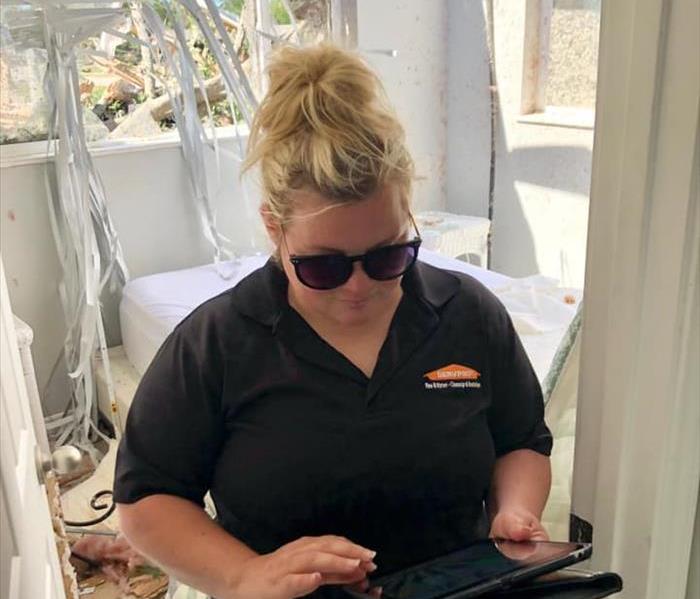 Storm damage experts
Storm damage experts
When heavy rains and high winds hit hard, property destruction and loss can be devastating to you as a homeowner. Structural damage to the exterior of your home is followed by interior devastation from water and winds. Storm damage is rarely isolated to just a few buildings in an area adding the challenge of finding a restoration company that can respond swiftly to your needs to an already anxiety provoking situation. SERVPRO delivers the help you need swiftly even when a local disaster is widespread as we are able to call upon a network of over 1,650 franchises nationwide to respond if the need is great.
Storm damage can feel overwhelming, but your fear and panic will disappear when our team of professionals responds to your water, wind and flooding repair and restoration needs. Your particular situation is of paramount importance to us, and you need not worry that your repairs and restoration will take a back seat even when many in your area are struggling to recover from the same issues you face. Choosing our company puts in motion a vast support system, but our local ownership means you will receive a personalized approach to your particular situation, efficiently returning your home back to its pre-storm condition just “Like it never even happened.”
Placing your trust in SERVPRO for your storm damage needs will reap you benefits that less qualified companies simply cannot deliver. We use state of the art equipment to clean, repair and restore your home and in the process, we also restore your and your family’s peace of mind. Our technicians are highly trained for any procedure needed to bring your home back to the comfortable and comforting refuge you deserve. We also work closely with your insurance company, ensuring that all the work necessary is approved and compensated according to the terms of your policy. Our high standards and relentless drive to do the job on time while meeting local specifications means you and your family will quickly return to the quiet enjoyment of your house and neighborhood. We are not satisfied until you are happily back in your restored dwelling.
We are here for you 24 hours a day, 7 days a week! Call 903-283-8100.
When Storms or Floods hit East Texas, SERVPRO is ready!
8/4/2019 (Permalink)
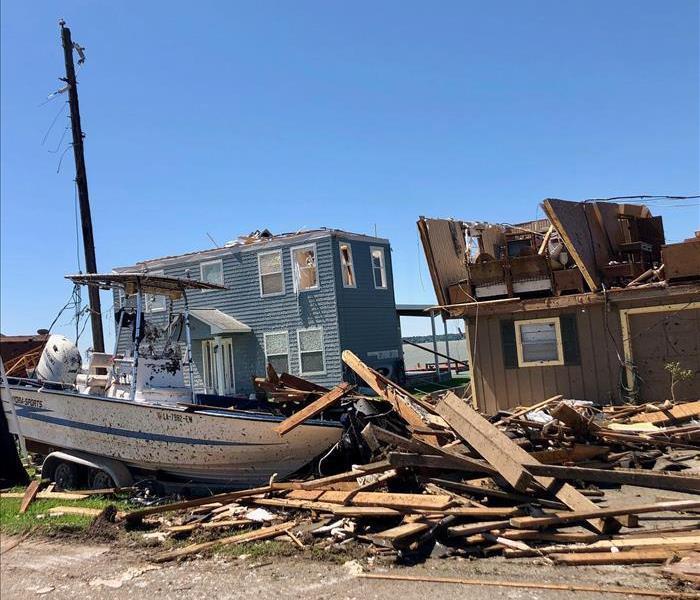 Our highly trained crews are ready to respond 24/7 to storm or flood damage in East Texas.
Our highly trained crews are ready to respond 24/7 to storm or flood damage in East Texas.
SERVPRO of Longview specializes in storm and flood damage restoration. Our crews are highly trained and we use specialized equipment to restore your property to its pre-storm condition.
Faster Response
Since we are locally owned and operated, we are able to respond quicker with the right resources, which is extremely important. A fast response lessens the damage, limits further damage, and reduces the restoration cost.
Resources to Handle Floods and Storms
When storms hit East Texas, we can scale our resources to handle a large storm or flooding disaster. We can access equipment and personnel from a network of 1,800 Franchises across the country and elite Disaster Recovery Teams that are strategically located throughout the United States.
Have Storm or Flood Damage? Call Us Today (903)238-8100
East Texas Storms
6/27/2019 (Permalink)
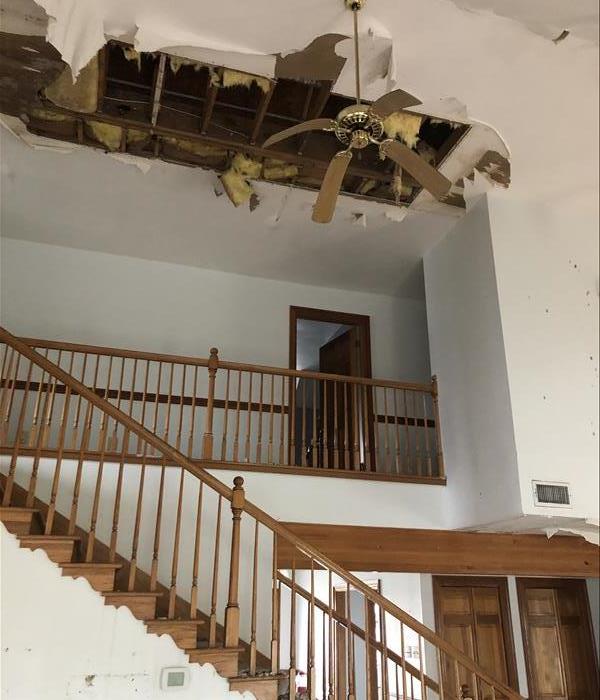 East Texas Storms can wreak havoc.
East Texas Storms can wreak havoc.
Summer comes with many fun things BBQ’s, swimming at the beach, camping and spending time with family. Summer seasons can also come with wind, rain, and thunder/ lightning storms. When heavy rains come we risk floods, and high winds can wreak havoc on the power lines and trees around your home.
Here are a few help tips to keep your home safe during the summer months:
- Have an emergency kit ready in your home including these items: flashlight, battery powered radio, extra batteries, canned and dry foods, water, can opener, first aid, fire extinguisher, blankets, extra clothes and shoes, flares or whistle to signal for help.
- Cut down any dead or unwanted trees and branches around your home.
- Know the safest structure of your home to go during a severe storm, make sure everyone in your household knows to meet here.
- Avoid electrical equipment and telephones, instead use your battery powered TVs and radios.
If you happen to be caught outside during a thunder storm:
- Never take shelter under a tree or tower, lighting tends to strike the tallest object in the area
- Leave if you’re in an elevated area such as on a hill, mountain or peak
- Get out and away from any body of water
- Stay away from anything that conducts electricity including wires and fences.
If your home is affected by a summer storm don’t hesitate to call SERVPRO of Longview 24 hours a day, 7 days a week at 903-238-8100. We are here to help!
A Power Outage
6/26/2019 (Permalink)
We’re more vulnerable to power outages this time of year because of new growth and leaves that are still on the trees, which can pull branches down. Ready, a national public service advertising campaign, gives us these tips to follow before, during, and after a power outage.
Before
- Build or restock your emergency preparedness kit, including a flashlight, batteries, cash, and first aid supplies.
- Make sure you have alternate charging methods for your phone or any device that requires power.
- Charge cell phones and any battery powered devices
- Know where the manual release lever of your electric garage door opener is located and how to operate it.
- Purchase ice or freeze water-filled plastic containers to help keep food cold during a temporary power outage.
- Keep your car’s gas tank full. Gas stations rely on electricity to power their pumps,. If you use your car to re-charge devices, do NOT keep the car running in a garage, partially enclosed space, or close to a home, this can lead to carbon monoxide poisoning.
- Learn about the emergency plans that have been established in your area by visiting your state’s or local website so you can locate the closest cooling and warming shelters.
- If you rely on anything that is battery-operated or power dependent like a medical device, determine a back-up plan.
During
- Only use flashlights for emergency lighting, candles can cause fires.
- Keep refrigerator and freezer doors closed. Most food requiring refrigeration can be kept safely in a closed refrigerator for several hours. An unopened refrigerator will keep food cold for about 4 hours. A full freezer will keep the temperature for about 48 hours.
- Put on layers of warm clothing if it is cold outside. Never burn charcoal for heating or cooking indoors. Never use your oven as a source of heat. If the power may be out for a prolonged period, plan to go to another location that has heat to keep warm.
- Turn off or disconnect appliances and other equipment in case of a momentary power “surge” that can damage computers and other devices. Consider adding surge protectors.
- If you are considering purchasing a generator for you home, consult an electrician or engineer before purchasing and installing.
- Only use generators away from your home and NEVER run a generator inside a home or garage, or connect it to your home’s electrical system.
After
- Throw away any food that has been exposed to temperatures 40 degrees Fahrenheit (4 degrees Celsius) for 2 hours or more or that has an unusual odor, color, or texture. When in doubt, throw it out!
- If food in the freezer is colder than 40 degree Fahrenheit and has ice crystals on it, you can refreeze it
- Contact your doctor if you’re concerned about medications having spoiled.
- Restock your emergency kit with fresh batteries, canned foods, and other supplies.
SERVPRO of Longview’s main priority this season is safety. For any water or fire damage needs, feel free to call us at 903-238-8100
Protecting your windows during a storm event
6/19/2019 (Permalink)
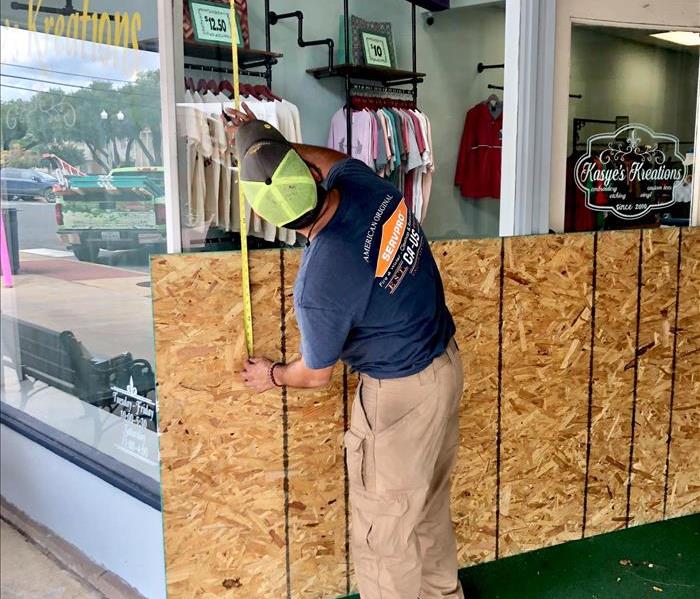 SERVPRO of Longview provides board up service for your home or business.
SERVPRO of Longview provides board up service for your home or business.
Some homes in Longview, Texas may be especially susceptible to high winds. However, you don’t have to sacrifice style and comfort to prevent windblown glass and exposure to the elements. Examine the following shutter designs to choose the best one for your home.
1. Traditional Designs
When many people picture shutters, they imagine a wooden frame on either side of the window with rows of slats. This is called the colonial design, and it is so common that many homes use a non-functional version as a decorative window accent. However, depending on the conditions in your area, the colonial shutter variety might be a solid choice for storm protection as well. Another traditional design called the Bahama shutter has vertical hinges, allowing it to open into a small awning to provide shade in warmer climates.
2. Modern Equipment
Other homeowners choose a sleek and compact look to keep their shutters out of the way when no high winds are present. Accordion and rolling shutters are made of light metals or polycarbonate, giving them a high degree of strength and flexibility. This enables the window cover to fold away or roll up when not in use. These designs are typically more expensive than the traditional varieties, and can even be electrically-powered for added convenience.
3. Temporary Protection
Storm panels and plywood are another window damage prevention method for those in high-risk locations. These storm shutters are not intended for permanent installation, and properly speaking, they do not “shut” over the window at all. Storm panels are corrugated metal surfaces that are simply affixed to the window frame with screws. Plywood is an even cheaper solution and can be implemented faster, but may not be as secure.
Whatever shutter option you choose, remember that protecting your home against high winds is the first step toward avoiding interior flooding. Have the contact information of a qualified water damage restoration service ready if you anticipate severe weather conditions.
A Storm is coming! Check your Gutters!
6/19/2019 (Permalink)
Did you know that a large percentage of damage homes suffer during a rain storm or hurricane is to the roof? Keeping your gutters clear and in good condition can help reduce the amount of damage your roof receives and how much water seeps into your home. The more prepared your are, the less damage you will have to face.
Here are some tips on how to prepare your roof gutters before a rain storm/hurricane:
- Get out your ladder. Go around your house and make sure your gutters are free of leaves and debris. This is a top tip from every government agency and safety service. By late fall, it’s likely more than half full of leaves that have fallen and they’ve clogged your gutters. Add a lot of rain, and it’s a receipt for water in your basement, leaky ceilings, and more.
- Extend you downspouts. Keeping water away from your foundation is critical when there is a lot of rain. A downspout that only extends the length of the curve can be dangerous. Even one that extends three feet isn’t good enough. Downspout extenders or even length of downspout attached to the downspout elbow can keep the ground around your home from getting over saturated. Water can seep through the walls of your foundation if the ground gets too wet.
- Check your window wells. Cover them if you can keep out excess water and debris. If a gutter were to clog, it’s often a window well that fills with water first. The seals around the windows won’t keep water from pouring into your home. Keep a bucket handy and check your window wells often during the storm. A little preemptive bailing can keep from a wet basement.
- Be courteous and don’t dump your leaves in the street. After gutter cleaning, you may want to dump all those leaves out to the street for pick up. Do your street storm drains a big help by not dumping them out there just yet. You’ll wind up putting a strain on local resources and services that, in a situation like this, should be going to more important issues. Storm drains will clog if the streets are taxed with extra leaves. They also make it more difficult to get to power lines or downed trees.
- Protect stuff in your basement. If there are places around your home prone to flood occasionally, even if you have dealt with your gutters before the storm, make sure you get them off of the ground.
Water damage after the storm can be devastating. Don’t hesitate to call SERVPRO of Longview 24 hours a day, 7 days a week at 903-238-8100.





 24/7 Emergency Service
24/7 Emergency Service
























